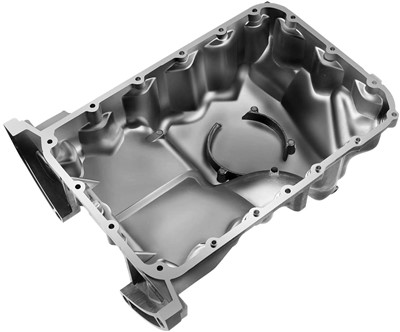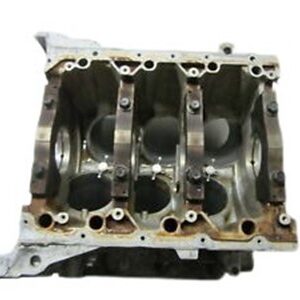Engine Oil Pan
The engine oil pan is a vital component seamlessly integrated into your vehicle’s engine system.
Precision-engineered and crafted, it securely attaches to the engine’s underside using robust bolts, serving as the primary reservoir for oil.
As the heartbeat of your engine, this oil pan facilitates the efficient circulation of oil, ensuring optimal lubrication, cleanliness, and cooling of crucial moving parts.
During an oil change, the oil pan plays a pivotal role in the extraction and replenishment of engine oil, promoting longevity and peak performance.
Designed for compatibility with a variety of engine types, our oil pan exemplifies durability and reliability across all brands.
Engineered to exact standards, it enhances overall engine efficiency by reducing friction between components, mitigating heat generation, and promoting a cleaner, cooler engine environment.
Trust in the quality and versatility of our oil pan, a cornerstone of engine maintenance, whether you prefer conventional or synthetic oil.
Elevate your driving experience with a product designed to exceed expectations.
$98.00
CompareEngine Oil Pan
The engine oil pan, also known as the oil pan or sump, is a critical component in an internal combustion engine’s lubrication system. It serves as the reservoir for engine oil, ensuring proper oil circulation throughout the engine and providing essential protection and support.
Material and Construction
The engine oil pan is constructed from materials selected for their strength, durability, and resistance to engine conditions:
- Steel: Traditional oil pans are often made from stamped steel. Steel offers a good balance of strength, weight, and cost-effectiveness. It can be formed into the necessary shape and provides adequate protection for the engine.
- Aluminum: Many modern oil pans use aluminum or aluminum alloys. Aluminum is lighter than steel and provides good resistance to corrosion and heat. It also allows for more complex shapes and designs.
- Composite Materials: Some high-performance and specialized vehicles use composite materials for the oil pan. These materials can provide a combination of strength, weight savings, and resistance to extreme conditions.
- Rubber or Gasket Materials: The oil pan features a gasket or sealing material made from rubber or other materials to prevent leaks between the pan and the engine block.
Design and Functionality
The engine oil pan is designed with several key features to ensure its effectiveness in the lubrication system:
- Oil Reservoir: The primary function of the oil pan is to act as a reservoir for engine oil. It collects and holds the oil that has drained from the engine and allows it to be pumped back into the engine for lubrication.
- Oil Pickup Tube: The oil pan contains an oil pickup tube or strainer, which is submerged in the oil. This tube draws oil from the pan and delivers it to the oil pump, ensuring a steady supply of oil to the engine.
- Drain Plug: The oil pan includes a drain plug at its lowest point. This plug allows for the easy removal of old oil during an oil change, facilitating maintenance and keeping the engine lubricated with clean oil.
- Baffles and Baffles: Inside the oil pan, there may be baffles or partitions designed to control the movement of oil. These features help to prevent oil slosh and ensure a consistent supply of oil to the pickup tube during high-speed or high-load conditions.
- Cooling and Protection: The oil pan may also serve as a cooling surface for the engine oil, helping to dissipate heat. Additionally, it provides protection for the oil pump and other components from debris and damage.
Performance and Benefits
The engine oil pan contributes to several important aspects of engine performance and reliability:
- Efficient Lubrication: By providing a reservoir for engine oil, the oil pan ensures that oil is readily available for lubrication, which is essential for reducing friction and wear on engine components.
- Improved Engine Cooling: The oil pan helps to dissipate heat from the engine oil, contributing to improved engine cooling and maintaining optimal operating temperatures.
- Leak Prevention: The gasket or sealing material around the oil pan helps to prevent oil leaks, which can cause low oil levels and potential engine damage.
- Protection and Durability: The oil pan protects the oil pump and other components from damage caused by debris and road hazards. Its durable construction ensures long-lasting performance.
Maintenance and Care
Proper maintenance and care of the engine oil pan are essential for ensuring its effectiveness and preventing potential issues:
- Regular Inspection: Periodically inspect the oil pan for signs of damage, such as cracks, dents, or leaks. Address any issues promptly to prevent further damage and ensure proper oil retention.
- Check for Leaks: Monitor the area around the oil pan for any signs of oil leaks. If you notice oil pooling or dripping, have the oil pan and gasket checked and repaired or replaced as needed.
- Oil Changes: Follow the manufacturer’s recommendations for oil change intervals and ensure that the drain plug is properly tightened after each oil change to prevent leaks.
- Professional Servicing: If you experience problems with oil pressure, oil leaks, or other issues related to the oil pan, consult a professional mechanic for inspection and repair. Proper diagnosis and maintenance are essential for maintaining optimal engine performance.
Advanced Features and Technologies
Modern oil pans may include advanced features to enhance their performance and functionality:
- Integrated Oil Coolers: Some oil pans feature integrated oil coolers to help regulate oil temperature and improve cooling efficiency.
- Enhanced Gaskets: Advanced gaskets or sealing technologies may be used to provide improved leak prevention and durability.
- Shielding and Protection: High-performance oil pans may include additional shielding or protective features to safeguard against road debris and extreme conditions.
- Improved Design: Modern oil pans may incorporate advanced design elements, such as improved baffling or oil control systems, to enhance performance and reliability.
Conclusion
The engine oil pan is a vital component of the engine’s lubrication system, providing a reservoir for engine oil, ensuring efficient lubrication, and protecting critical components. Its durable construction, effective design, and essential functions contribute to overall engine performance and reliability. Regular maintenance and timely care of the oil pan are important for preventing issues and ensuring optimal operation. By understanding the functions and benefits of the engine oil pan, vehicle owners can maintain their engine’s performance and longevity.
Based on 0 reviews
Be the first to review “Engine Oil Pan” Cancel reply
Related products
-
Engine
Clutch Fork
0 out of 5(0)A clutch fork is an integral component within a vehicle’s clutch system, facilitating the seamless engagement and disengagement of the clutch.
Functioning as a critical link between the clutch pedal and the clutch throw-out bearing, the clutch fork translates the movement initiated by the clutch pedal into the necessary back-and-forth motions required for the clutch’s efficiency.
Crafted with precision, the fork plays a pivotal role in ensuring a smooth transition between gears, enhancing overall driving performance.
This high-quality clutch fork is designed to meet the stringent demands of modern automotive systems, offering reliability and durability across diverse driving conditions.
Its robust construction guarantees longevity, providing drivers with confidence in their vehicle’s clutch functionality.
Compatible with various vehicle makes and models, this clutch fork seamlessly integrates into different automotive systems, delivering consistent performance.
Trust in the superior design and engineering of this clutch fork, a key component contributing to the optimal functioning of your vehicle’s clutch system.
SKU: n/a -
Engine
OCC Chopper CNC Mount For 2-Stroke 66CC-80CC Gas Motorized Engine
0 out of 5(0)Introducing the OCC Chopper CNC Mount for 2-Stroke 66CC/80CC Gas Motorized Engines—a precision-engineered solution for optimal engine placement on your OCC Chopper Frame.
Crafted from lightweight Aluminum, this CNC Engine Mount is exclusively designed for use with our 2-stroke Chinese 66cc/80cc Engine or similar models, ensuring a perfect fit.
Experience reduced kit weight and enhanced vibration resistance, thanks to the aluminium construction, providing stability during your rides.
The sleek design not only adds an aesthetic touch but also offers a perfect offset to align your drive sprocket seamlessly with the rear one.
This mount is a paragon of stability, providing a secure foundation for your engine.
Noteworthy for its accuracy, the OCC Chopper CNC Mount offers ample space for customization, allowing easy integration of high-performance parts such as Mikuni and clone carburetors.
Elevate your riding experience with this superior-quality CNC mount—a testament to precision engineering and durability.
Explore the possibilities of enhanced performance and style with OCC Chopper CNC Mount.
SKU: n/a -
Engine
Engine Block
0 out of 5(0)Engine Blocks, also known as Cylinder Blocks, stand as the robust foundation of automotive powerhouses.
Meticulously engineered, they house essential components such as cylinders, intake and exhaust passages, coolant channels, and crankcases.
Crafted with precision, our Engine parts ensure optimal performance and longevity, delivering the reliability your vehicle demands.
These parts seamlessly integrate with various systems, offering a harmonious synergy that propels your vehicle’s efficiency to new heights.
Trust in the durability and functionality of our Engine Blocks, meticulously designed to meet the highest standards of automotive excellence.
Elevate your driving experience with a powerhouse that embodies innovation and quality – because every journey deserves the reliability that comes with our exceptional Engine parts.
SKU: n/a -
Engine
Engine Cylinder Head
0 out of 5(0)The engine cylinder head, a critical component in internal combustion systems, serves as the upper enclosure for the combustion chamber, housing essential elements such as spark plug sockets and injector holders.
Crafted with precision, our flex plate seamlessly connects the engine’s output to the torque converter in automatic transmission vehicles.
This metal disk replaces the traditional flywheel in manual setups, ensuring smooth power transfer. Compatible with various brands, our flex plate guarantees reliability and durability, meeting the highest industry standards.
Trust in the engineering excellence of our flex plate to optimize your vehicle’s performance and transmission efficiency.
Upgrade your driving experience with a flex plate that transcends brand boundaries, delivering unparalleled quality and compatibility.
Drive with confidence, knowing your vehicle is equipped with a top-tier flex plate designed for seamless integration and superior performance.
SKU: n/a -
Engine
New AD AutoParts Front Engine Mount For Pilot Ridegeline Acura TL CL MDX
0 out of 5(0)Introducing the New AD AutoParts Front Engine Mount for Pilot Ridgeline Acura TL CL MDX.
Motor mounts play a pivotal role in ensuring a vehicle’s smooth operation by preventing engine movement during use.
Similar to tires and floor mats, motor mounts can wear out over time. Recognizing the importance of a reliable motor mount, our product is meticulously crafted with high-quality composite metal and molded rubber.
This construction effectively controls heavy engine vibrations, safeguarding your vehicle’s systems from potential damage caused by excessive movements.
Designed to surpass the standards of original motor mounts, the New AD AutoParts Front Engine Mount for Pilot Ridgeline Acura TL CL MDX provides exceptional form, fit, and function.
If you observe cracked or deteriorating rubber in your current motor mount, it’s time to consider a replacement.
Our motor mount not only minimizes engine vibration in the compartment but also offers additional support to your engine and transmission while reducing overall engine noise.
Choose the assurance of ENA for a smooth and stable driving experience.
SKU: n/a









There are no reviews yet.